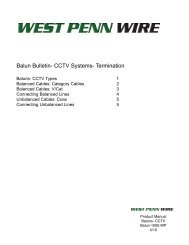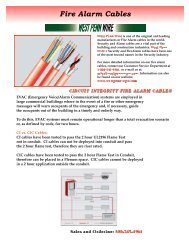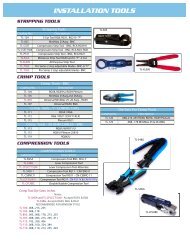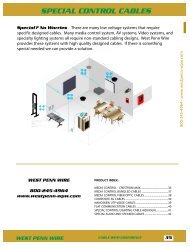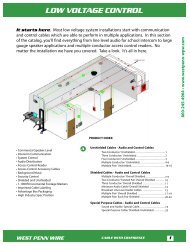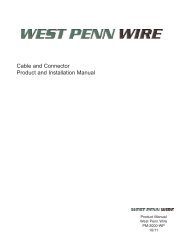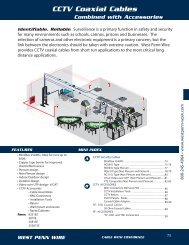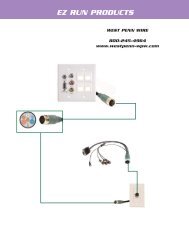Create successful ePaper yourself
Turn your PDF publications into a flip-book with our unique Google optimized e-Paper software.
Coaxial Cable Construction<br />
This section provides an introduction to understanding coaxial cable construction. These fundamentals will allow you to understand<br />
the basic materials that are used in the construction of a coaxial cable. A coax cable type is determined by the specifications<br />
of the system installed, basic electronic principles, environment, and regulatory agencies. These various criteria dictate the<br />
type of conductor, gauge of wire, type of insulation, shielding, and type of jacket. A basic understanding of coaxial cable construction<br />
should be helpful in selecting and installing the proper cable for a particular system.<br />
Conductors<br />
Conductors for coaxial cables can vary greatly from stranded conductors<br />
for maximum flexibility to copper covered steel which provides<br />
a stronger cable that will withstand a greater physical strain<br />
than copper. The American Society For Testing and Materials<br />
(ASTM) standards are followed for all of <strong>West</strong> <strong>Penn</strong> <strong>Wire</strong> conductor<br />
materials. The ASTM Standard defines standard requirements such<br />
as tensile strength, elongation, resistivity, dimensions, permissible<br />
variations, finish, inspection and testing.<br />
Conductor Material<br />
There are several types of material that conduct electricity well (aluminum,<br />
nickel, gold, silver). However, copper is the most popular<br />
due to its excellent conductivity compared to other material cost.<br />
<strong>West</strong> <strong>Penn</strong> <strong>Wire</strong> uses a variety of conductors in our cable. Material<br />
used can be bare copper, tinned copper, and copper covered steel.<br />
The conductor can consist of solid or stranded construction. The<br />
type of conductor selected is determined by the application the<br />
cable will be used for.<br />
Solid Conductors<br />
A copper rod provides a solid conductor for a wire. A solid conductor<br />
offers lower cost and is easily formed to any shape desired. A<br />
solid conductor does not have much flexibility and may break if<br />
flexed too much in one place. For these reasons, a solid conductor is<br />
best suited for use in a fixed or permanent installation.<br />
Stranded Conductors<br />
By combining several strands together, a stranded conductor can be<br />
formed. A stranded conductor is easy to pull, is flexible and is less<br />
likely to break if subjected to frequent bending. The finer the<br />
strands and the more strands used to assemble a conductor the more<br />
flexible the conductor becomes. Therefore, stranded cable is ideal<br />
for installations where frequent movement of the cable is required.<br />
Bare and Tinned Conductors<br />
Conductors can be either tinned or plain bare copper. Most electronic<br />
connectors today are designed to be used with bare copper. In<br />
cables that are terminated with soldered connectors, tinned plated<br />
conductors can help in soldering the wire to the connector.<br />
Copper-Covered Steel<br />
This type of conductor uses a steel conductor covered with copper.<br />
This type of conductor make-up is used for RF applications that<br />
require a cable to withstand added tension. The steel provides<br />
added strength and the copper provides good conductivity for higher<br />
RF signals such as CATV. This type of conductor is not good for<br />
low frequency transmission, such as CCTV.<br />
186<br />
Technical Reference<br />
Dielectric<br />
A coaxial cables dielectric is a highly resistive material that is<br />
applied to the conductor to resist the flow of electric current to the<br />
shield. It also sets up a cables electrical characteristics. There are<br />
several types of insulation materials and constructions used and<br />
each has its advantages and limitations. The type of insulation<br />
selected is based upon the application of the cable. Insulation is<br />
also referred to as the dielectric of a cable.<br />
Solid Dielectric Construction<br />
A solid dielectric construction uses a process of extruding a solid<br />
material over the center conductor of a coaxial cable. It provides<br />
good electricals, added cable strength and uniformity of termination.<br />
However, a solid dielectric provides poorer electricals and less<br />
velocity of propagation than cellular designs.<br />
Foamed (Cellular) Dielectric Construction<br />
A cellular dielectric construction uses a process of extruding a cellular<br />
material over the center conductor of a coaxial cable. This<br />
improves the dielectric constant of the dielectric material which<br />
improves the electricals of a coaxial cable. The dielectric material<br />
exhibits a lower capacitance, which in turn provides lower loss.<br />
This dielectric material also provides a higher velocity of propagation.<br />
With the advent of the "Gas Injection" process, cable manufacturers<br />
are able to improve their cellular design and provide a lower<br />
loss cable with higher velocity of propagation values.<br />
Dielectric Materials<br />
Polyethylene<br />
This compound offers excellent electrical properties providing for<br />
low loss of a signal. However, it can only be used on a non-plenum<br />
rated cable because the compound has a poor flame and smoke<br />
retardancy.<br />
Teflon ® (FEP)<br />
A premium insulation that provides excellent electrical and<br />
mechanical properties. This compound is widely used as a dielectric<br />
for coaxial cables providing low loss and the ability to withstand<br />
high temperatures and also having low flame and smoke<br />
characteristics.



